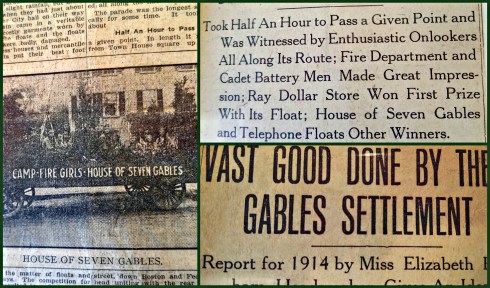The House of the Seven Gables is featuring a new exhibit on its founder, Caroline O. Emmerton (1866-1942) in commemoration of the sesquicentennial of her birth and as the rather mysterious Caroline has long intrigued me I took advantage of a preview invitation to check it out even before the official opening. Despite her fortunate birth into one of Salem’s wealthiest and most philanthropic families, her connections, and her achievements, Caroline is a bit enigmatic, and I was hoping that Caroline Emmerton. An Unbounded Vision would shed new light on her for me. It did, but my suspicion that Caroline can only really be known in context rather than strictly on her own was confirmed. The exhibit actually presents Caroline in several contexts and it is through these perspectives that we come to know her: the wealth, privileges, and sense of civic duty that came to her through her family, her interest in the emerging Settlement Movement, with its aims of aiding and assimilating (or “Americanizing”) the country’s expanding immigrant communities, and the corresponding Preservation Movement, which aimed to preserve the pre-industrial past in an era of dynamic change. You can definitely perceive how Salem shaped her. The exhibit appropriately emphasizes Caroline’s settlement activities over her preservation goals but you certainly get the sense that they are going to merge with the formation of the House of the Seven Gables Settlement Association in 1910.






Caroline Emmerton: an Unbounded Vision, at the House of the Seven Gables through August 31: A young Caroline and a very famous photograph of her with children at the Settlement House c. 1920; Exhibition panels, which were also produced in Spanish (a 21st-century update on Caroline’s settlement goals).



Context, context: the Gables in the Community. Great photograph of a Derby Street factory and worker, instructing neighborhood girls in the Settlement House kitchen; newspaper clippings from a Gables scrapbook.
So the context was definitely there but what about the personal Caroline? There was a sense of her in the exhibit, actually: a photograph of her home on Essex Street (with a wallpaper sample and a few household possessions), a range of photographs of her at different stages in her life, an original notepaper version of her (very ye Olde) tour for the Gables, and my favorite, the hand-written manuscript of her book Chronicle of Three Old Houses, which she published in 1935 for the 25th anniversary of the Gables. It was lovely to see these things, and also to talk with Irene Axelrod, the former Research Librarian of the Phillips Library of the Peabody Essex Museum, who knows more about Caroline than anyone else. I asked Irene where Caroline went to school, because in my experience institutions often offer up lots of evidence, and she said that Caroline was tutored at home and then probably went on the Grand Tour. So there goes that source. Irene told me that her research forayed into oral history, and she was able to interview some (quite old) people that actually knew Caroline. So that’s about as close as I’m going to get, I think: four degrees of separation?


LOVE this handwritten manuscript of Caroline’s Chronicles of Three Old Houses complete with little intextual illustrations! The companion book to the exhibition by David Moffat features a full-page view, along with lots of other illustrations from the Gables archives, sources, and more context.






April 10th, 2016 at 12:00 pm
Hi Donna,
Another great piece. Caroline was certainly a lovely looking gal.
You mentioned, “I asked Irene where Caroline went to school, because in my experience institutions often offer up lots of evidence, and she said that Caroline was tutored at home and then probably went on the Grand Tour.”
That scenario was typical of the period. Similar to the experience of one of my favorite writers, a contemporary of Caroline’s – Edith Wharton (1862-1937). Most of these young women of this ilk read widely from their fathers’ ample libraries. Then the “grand tour.” Thanks for sharing …
April 10th, 2016 at 1:24 pm
Thanks Helen. I think you’re right, for women who belonged to the more privileged class such as Edith and Caroline. C. was a lovely young woman, but I don’t think she aged well! I omitted her obituary photo, which is in the exhibition, just because I didn’t think it favored her!
April 12th, 2016 at 6:34 am
Reblogged this on Lenora's Culture Center and Foray into History.